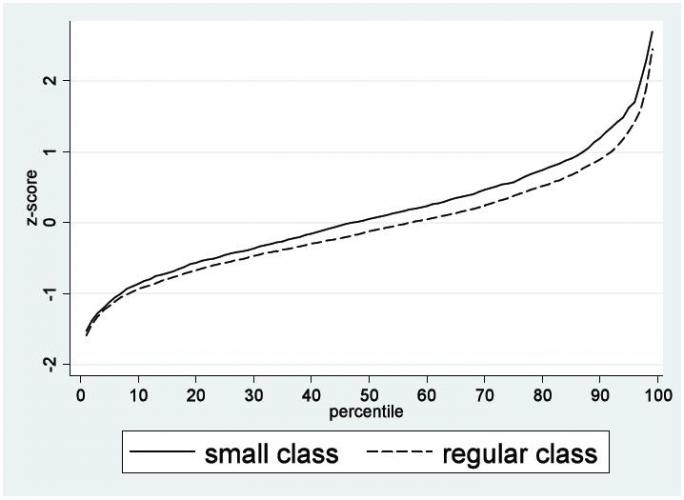Small Class Sizes Yield Higher Test Scores Among Young Children
Marianne Page, UC Davis; and Erika Jackson, University of California Office of the President
Smaller classes help students, many argue, especially those most “at risk.” Research shows that on average this is true. However, when “risk” is defined beyond ethnicity or socioeconomic status, the picture of who most benefits becomes less clear.
In a recent study on early childhood education, Center for Poverty Research Deputy Director Marianne Page, and Erika Jackson a former graduate student in the Sociology Department at UC Davis, find that smaller class sizes yield the highest test-score increases among high-achieving children, but also that African American children at nearly every test score percentile benefit most.
Key Findings
• Gains in test scores from smaller class sizes are largest for the highest-scoring students.
• Differences in test scores at nearly every percentile are larger for African American children than for white children.
• Policymakers should think carefully about the definition of “at risk” when evaluating the distributional effects of education policies.
As education policies go, class-size reduction has been among the most widely supported policies in the U.S. These policies have often been formulated under the auspices of improving educational opportunities for disadvantaged students.
During the 2006-07 school year, California dedicated over $1.7 billion to keep K-3 classes to no more than 20 students. At the federal level, the Clinton administration’s 1999 budget proposal included $12 billion to reduce class sizes. The Tennessee STAR (Student-Teacher Achievement Ratio) experiment was commissioned by the Tennessee state legislature from 1985-89. It involved over 11,000 elementary school students. Most analyses of Project STAR conclude that smaller classes increase average test scores.
These studies do not focus on low-achieving students per se. Instead, they focus on subgroups that typically have low achievement, such as minorities and children from low-income families. One problem with this approach is that the impact of class-size reduction policies may vary more within subgroups than across subgroups.
To understand how education policies affect children at different achievement levels is critical to answering one of the center-stage questions in education policy: how can resources be optimally allocated so as to increase achievement for students at risk of failure without compromising the learning opportunities of more advantaged children?
Comparing achievement
Project STAR randomly assigned K-3 students at public schools to
either a small class (13 to 17 students), a regular-size class
(22 to 25 students), or a regular-size class with a full-time
teacher’s aide. The schools were large and small, urban and
rural, and from wealthy and poor districts. As a result, the
schools included in Project STAR are thought to include most of
the educational conditions that exist in the U.S.
This study focuses on children in kindergarten and first grade. The measure of achievement is the Stanford Achievement Test that includes math, reading and word identification. For their analysis, the researchers combined all subject scores into a single composite score.
Rather than measure the average differences between small- and regular-sized classes, as most studies have done, this study measured the differences in test scores between small- and regular-sized classes by percentile. For example, the difference in test scores between the 10th percentile of students in small classes and the 10th percentile of students in regular-sized classes estimate the impact of class size for students at 10th percentile scores.
Real benefits in smaller classes
While students in smaller classes scored higher overall than
those in regular-sized classes, the biggest differences was
between students with the highest scores. Among kindergarteners,
students at the 90th percentile in a small class scored about 1/3
of a standard deviation higher than 90th-percentile students in
regular classes. The differences at the 10th percentile are less
than ten percent of a standard deviation.
These findings seem to be at odds with earlier studies that found smaller classes most benefit disadvantaged children, specifically minorities and children from low-income families who typically score lower on standardized tests. By estimating the differences at all points in the test-score distribution, rather than comparing average differences in test scores between groups divided by ethnicity or socioeconomic status, the researchers found a more complicated picture.
This study found no benefits from smaller classes among low-income children in kindergarten or first grade. However, it did find larger benefits among African American children than among white children at nearly every point in the test-score distribution. In other words, the benefit among African American children is nearly always more than the gain to white children.
Defining “at-risk” children
Why do high achievers benefit more from smaller classes? One
hypothesis is that in small classes teachers are better able to
identify high achievers and to use instructional approaches that
work well for them. However, it is hard to imagine why this
benefits high-achieving students more than low achievers.
One possibility is that high achievers are, on average, more motivated than low achievers, which allows them to take better advantage of targeted instruction. This possibility might be particularly salient if teachers in smaller classes spend less time dealing with disruptive behavior and have more time to devote to on-task learning opportunities.
This study’s conclusions call into question how we define vulnerable students. This may have implications for how we evaluate education policies such as school accountability, voucher programs, and curricular development. As we see in the case of Tennessee STAR, we might draw different conclusions about who benefits if we use a broader definition of which students are “at risk.”
Meet the Researchers
Marianne Page is the Deputy Director of the Center for
Poverty Research, and Professor of Economics at UC Davis. Her
poverty-related research focuses on intergenerational mobility,
and the impact of social programs on children’s outcomes.
Erika Jackson is Associate Director of Policy and Analysis for the UCD Department of Admissions.













